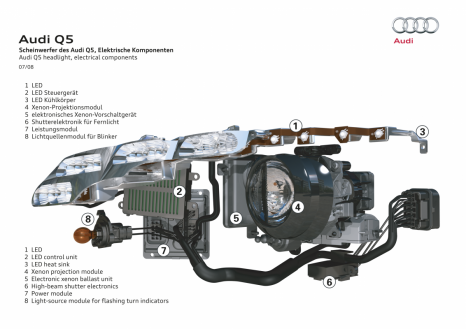Xenon plus headlights
Xenon headlights are gas discharge lamps. Two tungsten electrodes are sealed in the burner, a thick-walled quartz glass cylinder filled with xenon gas. A concentrated electric arc burns between the electrodes, and the inert gas filling exerts a pressure of as much as 100 bar (1,450.38 psi). The xenon gas itself gives off a somewhat violet light. Metallic salts in the filling of the gas cylinder reduce its color temperature to 4,200 Kelvin.
Audi has long since eliminated the mercury once commonly used to ignite and operate the burner from its xenon headlights. Effective 2012, the EU will withdraw its special dispensation permitting the use of mercury in xenon lamps. Audi leads the competition in this environmental area, too.
Xenon headlights provide a much brighter light and illuminate the road better than halogen incandescent lamps. Including the power required by the ballast, their energy consumption is roughly 20 percent lower. They also last much longer. Audi offers xenon plus headlights in every model in its line-up, either as standard or as an option. With this technology, a single burner provides both the high and low beam. An aperture is used to switch between the two. The xenon module is swiveled electromechanically for the adaptive light.
Status: 2011
